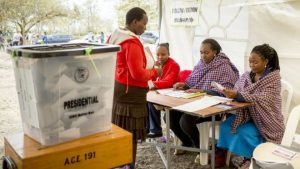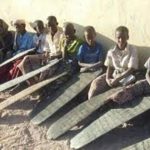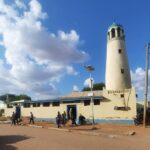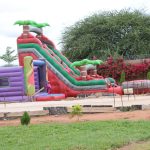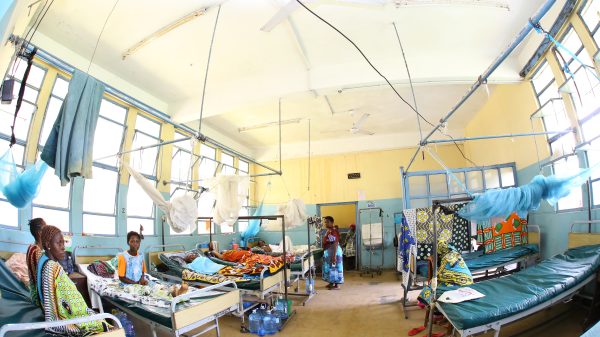By Abdullahi Jamaa
Sorry for Mr. Dubow Abdille who has had to sit helplessly under the scorching temperatures, he occasionally rubs sweat rolling down his lone face.
“I have walked for some 100km to look for twenty liters of water for my family. In the next few days to come the number of kilometers will have to increase because water sources will dry completely, my life is in danger” explains Mr. Abdille.
His eyes are staring into an endless bee line of herders waiting for water at Qurmole, a drought-hit pastoral village some 120KM west of Wajir town.
“I cannot stand up, leave alone joining the line for the water, I am so much exhausted by the long trek, at least I was safe to reach here alive” says the 50-year-old herder.
His village, is facing a severe water shortage this dry season after most of its water points and wells dried up due to the prolong drought.
With dry lips on his mouth at such a bad and bitter noon hours of a dry season when the sun is biting like a malevolent snake, Mr. Abdille occasionally felt he was tottering on the edge of death as climate change gets red in tooth and claw.
“Every season these years, life gets tough; we are only waiting for our day to come. Lack of water is the biggest problem this time” he observes.
With seven people to feed on that few liters of water back home, including his 8-months pregnant wife, there is no escape from the recurring drought conditions.
He says “There is no way out of the woods at the moment, the change in the pattern of seasons is having a profound impact in our lives, for the current season, there is little anticipation for rains”
A severe drought in 2006 has seen him lose 250 of his 300 heads of cattle, the worst effect of harsh seasons in the past few years.
And the increase of the distance to the nearest water sources made him apprehensive every time he starts trekking for water.
“Two or three years ago the distance for water was much shorter than the current one, but it has been increasing as the drought worsened every passing season. My biggest worry is that we will not be able to survive walking for so long anymore” he says
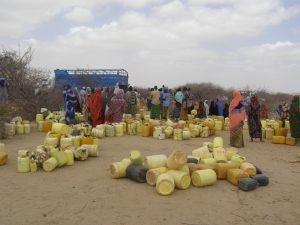
Like him, millions of herders in Kenya and in the Horn-of-Africa region are at risk of starvation as shortage of food and water loomed large in their eyes.
Over the past decades, the entire region has been bracing for long hot seasons with record heat and scarce water.
In a semi-barren field at Gerile pastoral village near the Kenyan-Somalia border, 60-year-old Mr. Abdulle Ahmed looks after 20 weak cows. “Before five years, I was a rich man with more than 500 cows … Now I am forced to beg for milk, because my wealth have died with successive droughts and the remaining ones are now dying because of lack of water” he said.
After every three days, Mr. Ahmed walks about 80km to a water trucking point, where he pays Sh. 10 for every cow to get water.
For mobile herders, buying water in times of drought, is a new challenge “This is an unusual experience for us herders, we never paid money before to water our livestock, we are wondering where seasons will take us next” worries Mr. Ahmed.
In the last few decades, cycles of droughts have repeatedly hit the Horn where estimated 17million pastoralists are surviving on the edge.
Population pressure, drought and changing weather patterns have caused most of watering points to dry up, totally changing the region’s vegetation cover and ushering in perennial water shortages.
Aid groups say more than half of the herding population in the region is short of water this dry spell, mainly affecting pastoral villages.
From Wajir in Kenya’s drought-prone Northeast, through war-torn Somalia to Ethiopia’s famine- famished Region Five, pastoral villages are showing signs of turning into deserts.
“Without water there is no sign of life. You can see slowly, slowly that the livestock is finishing. If the drought continues, life will also finish,” says Mrs. Suldana Muhumed a herder in Wajir.
Lack of water has withered vegetation cover and devastated herds of nomadic tribes. People must trek for miles with plastic jugs strung over their shoulders to get water from tankers supplied by government and NGO’s.
In a race against the clock, pastoralism is getting archaic and it is no longer a viable way of life due to unprecedented change of seasons.
According to Oxfam international poverty-stricken herders in Africa are already being hit hard by the effects of global warming, including increased drought.
OXFAM says by 2020, between 75 and 250 million of people in Africa are predicted to be exposed to increased water shortage due to climate change.
In the drought-devastated Northern Kenya, this translates into the occurrence of cyclic droughts with little and unpredictable rainfalls.
Since early 80’s this region of Kenya, which has been the epicenter of repeated dry spells suffered a huge human and economic cost.
Mr. Abdille the herder, is battening down the hatches “year in year out drought is there with us, we have had four seasons without enough rains now, and this is very strange.” he finally says



